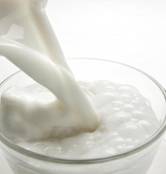Milk
Dairy is a place where handling of milk and milk products is done and technology refers to the application of scientific knowledge for practical purposes.
MILK COMPOSITION
| S.No |
Constituents |
Buffalo |
Cow |
Goat |
Liquid skimmed milk |
| 1 |
Moisture (g) |
81.00 |
87.50 |
86.80 |
92.10 |
| 2 |
Protein (g) |
4.30 |
3.20 |
3.30 |
2.50 |
| 3 |
Fat (g) |
6.50 |
4.10 |
4.50 |
0.10 |
| 4 |
Minerals (g) |
0.80 |
0.80 |
0.80 |
0.70 |
| 5 |
Carbohydrates (g) |
5.00 |
4.40 |
4.60 |
4.60 |
| 6 |
Energy calories (kcal) |
117.00 |
67.00 |
72.00 |
29.00 |
| 7 |
Calcium (mg) |
210.00 |
120.00 |
170.00 |
120.00 |
| 8 |
Phosphorus (mg) |
130.00 |
90.00 |
120.00 |
90.00 |
| 9 |
Iron (mg) |
0.20 |
0.20 |
0.30 |
0.20 |
PROCESSING
Pasteurization of milk

The term pasteurization, as a applied to market milk today, refers to the process of heating every particle of milk to at least 63 for 30min, or 72 for 30min, or 72 for 15sec (or to any temperature-time combination which is equally efficient), in approved and properly operated equipment. After pasteurization, the milk is immediately cooled to 5 for 15sec (or to any temperature-time combination which is equally efficient), in approved and properly operated equipment. After pasteurization, the milk is immediately cooled to 5 or below. or below.
METHODS OF PASTEURIZATION
In this case bottles filled with raw milk and tightly sealed with special caps are held at 63 to 66 for 30min. Then the bottles passed through water space of decreasing temperature, which cool both the product and the bottle. In this case there is greater risk of bottle breakage also special types of water-tight caps required to be used. One of the advantages is that it prevents the possibility of post- pasteurization contamination. for 30min. Then the bottles passed through water space of decreasing temperature, which cool both the product and the bottle. In this case there is greater risk of bottle breakage also special types of water-tight caps required to be used. One of the advantages is that it prevents the possibility of post- pasteurization contamination.
In this case the milk is heated to 63 for 30min and promptly cooled to 5 for 30min and promptly cooled to 5 or below and thus heating is done indirectly. The heat moves through a metal wall into the product for heating, and out of the product for cooling. The Pasteurizer may of 3 types. or below and thus heating is done indirectly. The heat moves through a metal wall into the product for heating, and out of the product for cooling. The Pasteurizer may of 3 types.
-
Water-Jacketed vat
-
Water-Spray type
-
Coil-vat type
In this case large volumes of milk are handled and it gives a continuous flow of milk which is heated to 72 for 15 sec and promptly cooled to 5 for 15 sec and promptly cooled to 5 or below. or below.
This refers to pasteurization of milk and there reduced pressure by direct steam. The equipment used is termed as ‘Vacreator’ and the process hence is known as ‘Vacreation’
This method consists of temperature-time combinations of 135 to 150 for no hold (a fraction of second). The success of this method depends on immediate aseptic packaging. for no hold (a fraction of second). The success of this method depends on immediate aseptic packaging.
Uprization term means ‘Ultra- pasteurization’ where in milk is heated with direct steam up to 150 for a fraction of second and thus the process is continuous. for a fraction of second and thus the process is continuous.
The formulation of the standards of pasteurization includes following points.
- Bacterial destruction
- Cream line reduction
- Phosphatase inactivation
VALUE ADDITION OF MILK
Source
www.sciencedaily.com/.../08/070808104257.htm
|

